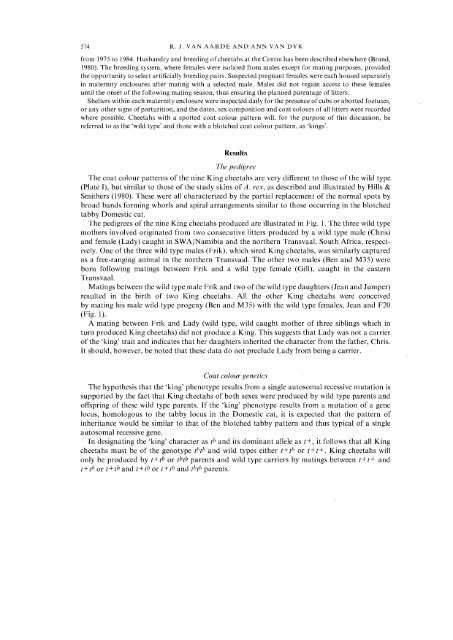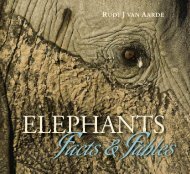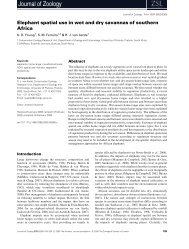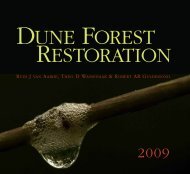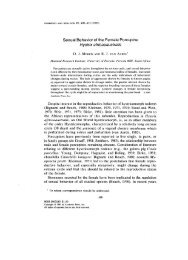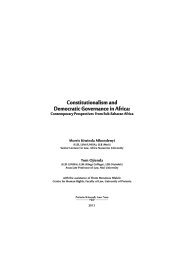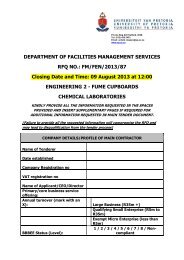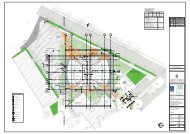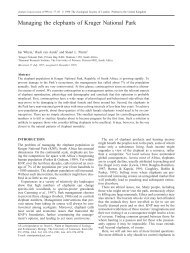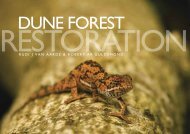Inheritance of the king coat colour pattern in cheetahs ... - CERU
Inheritance of the king coat colour pattern in cheetahs ... - CERU
Inheritance of the king coat colour pattern in cheetahs ... - CERU
You also want an ePaper? Increase the reach of your titles
YUMPU automatically turns print PDFs into web optimized ePapers that Google loves.
574 R.1. VAN AARDE AND ANN VAN DYK<br />
from 1975 to 1984. Husbandry and breed<strong>in</strong>g <strong>of</strong><strong>cheetahs</strong> at <strong>the</strong> Centre has been described elsewhere (Brand,<br />
1980). The breed<strong>in</strong>g system, where females were isolated from males except for mat<strong>in</strong>g purposes, provided<br />
<strong>the</strong> opportunity to select artificially breed<strong>in</strong>g pairs. Suspected pregnant females were each housed separately<br />
<strong>in</strong> maternity enclosures after mat<strong>in</strong>g with a selected male. Males did not rega<strong>in</strong> access to <strong>the</strong>se females<br />
until <strong>the</strong> onset <strong>of</strong> <strong>the</strong> Collow<strong>in</strong>g mat<strong>in</strong>g season, thus ensur<strong>in</strong>g <strong>the</strong> planned parentage <strong>of</strong> litters.<br />
Shelters with<strong>in</strong> each maternity enclosure were <strong>in</strong>spected daily for <strong>the</strong> presence <strong>of</strong> cubs or aborted foetuses,<br />
or any o<strong>the</strong>r signs oCparturition, and <strong>the</strong> dates, sex composition and <strong>coat</strong> <strong>colour</strong>s <strong>of</strong> all litters were recorded<br />
where possible. Cheetahs with a spotted <strong>coat</strong> <strong>colour</strong> <strong>pattern</strong> will, for <strong>the</strong> purpose <strong>of</strong> this discussion, be<br />
referred to as <strong>the</strong> 'wild type' and those with a blotched <strong>coat</strong> <strong>colour</strong> <strong>pattern</strong>, as '<strong>k<strong>in</strong>g</strong>s'.<br />
Results<br />
The pedigree<br />
The coa t <strong>colour</strong> <strong>pattern</strong>s <strong>of</strong> <strong>the</strong> n<strong>in</strong>e K<strong>in</strong>g <strong>cheetahs</strong> are very different to those <strong>of</strong> <strong>the</strong> wild type<br />
(Plate I), but similar to those <strong>of</strong> <strong>the</strong> study sk<strong>in</strong>s <strong>of</strong> A. rex, as described and illustrated by Hills &<br />
Smi<strong>the</strong>rs (1980). These were all characterized by <strong>the</strong> partial replacement <strong>of</strong> <strong>the</strong> normal spots by<br />
broad bands form<strong>in</strong>g whorls and spiral arrangements similar to tbose occurr<strong>in</strong>g <strong>in</strong> <strong>the</strong> blotched<br />
tabby Domestic cal.<br />
The pedigrees <strong>of</strong> <strong>the</strong> n<strong>in</strong>e K<strong>in</strong>g cbeetahs produced are illustrated <strong>in</strong> Fig. 1. The three wild type<br />
mo<strong>the</strong>rs <strong>in</strong>volved orig<strong>in</strong>ated from two consecutive litters produced by a wild type male (Chris)<br />
and female (Lady) caught <strong>in</strong> SWAjNamibia and <strong>the</strong> nor<strong>the</strong>rn TransvaaL South Africa, respectively.<br />
One <strong>of</strong> <strong>the</strong> three wild type males (Frik), which sired K<strong>in</strong>g <strong>cheetahs</strong>, was similarly captured<br />
as a free-rang<strong>in</strong>g animal <strong>in</strong> <strong>the</strong> nor<strong>the</strong>rn TransvaaL The o<strong>the</strong>r two males (Ben and M35) were<br />
born follow<strong>in</strong>g mat<strong>in</strong>gs between Prik and a wild type female (Gill), caught <strong>in</strong> <strong>the</strong> eastern<br />
TransvaaL<br />
Mat<strong>in</strong>gs between <strong>the</strong> wild type male Frik and two <strong>of</strong> <strong>the</strong> wild type daughters (Jean and Jumper)<br />
resulted <strong>in</strong> <strong>the</strong> birth <strong>of</strong> two K<strong>in</strong>g <strong>cheetahs</strong>. All <strong>the</strong> o<strong>the</strong>r K<strong>in</strong>g <strong>cheetahs</strong> were conceived<br />
by mat<strong>in</strong>g his male wild type progeny (Ben and M35) with <strong>the</strong> wild type females, Jean and F20<br />
(pig. 1).<br />
A mat<strong>in</strong>g between Prik and Lady (wild type, wild caught mo<strong>the</strong>r <strong>of</strong> three sibl<strong>in</strong>gs which <strong>in</strong><br />
turn produced K<strong>in</strong>g <strong>cheetahs</strong>) did not produce a K<strong>in</strong>g. This suggests that Lady was not a carrier<br />
<strong>of</strong> tbe '<strong>k<strong>in</strong>g</strong>' trait and <strong>in</strong>dicates that her daughters <strong>in</strong>herited <strong>the</strong> cbaracter from <strong>the</strong> fatber, Cbris.<br />
It sbould, however, be noted that <strong>the</strong>se data do not preclude Lady from be<strong>in</strong>g a carrier.<br />
Coat <strong>colour</strong> genetics<br />
The bypo<strong>the</strong>sis that <strong>the</strong> '<strong>k<strong>in</strong>g</strong>' pbenotype results from a s<strong>in</strong>gle autosomal recessive mutation is<br />
supported by <strong>the</strong> fact tbat K<strong>in</strong>g cbeetabs <strong>of</strong> both sexes were produced by wild type parents and<br />
<strong>of</strong>fspr<strong>in</strong>g <strong>of</strong> tbese wild type parents. If <strong>the</strong> '<strong>k<strong>in</strong>g</strong>' phenotype results from a mutation <strong>of</strong> a gene<br />
locus, homologous to <strong>the</strong> tabby locus <strong>in</strong> <strong>the</strong> Domestic cat, it is expected that <strong>the</strong> <strong>pattern</strong> <strong>of</strong><br />
<strong>in</strong>heritance would be similar to tbat <strong>of</strong> <strong>the</strong> blotched tabby <strong>pattern</strong> and thus typical <strong>of</strong> a s<strong>in</strong>gle<br />
autosomal recessive gene.<br />
In designat<strong>in</strong>g <strong>the</strong> '<strong>k<strong>in</strong>g</strong>' character as tb and its dom<strong>in</strong>ant allele as t + , it follows that all K<strong>in</strong>g<br />
<strong>cheetahs</strong> must be <strong>of</strong> <strong>the</strong> genotype tbt b and wild types ei<strong>the</strong>r /+ /" or t+ t+. K<strong>in</strong>g <strong>cheetahs</strong> will<br />
only be produced by t+tb or {btb parents and wild type carriers by mat<strong>in</strong>gs between /+/+ and<br />
t+ tb or t+ tb and t+ tb or t+ tb and tbtb parents.


